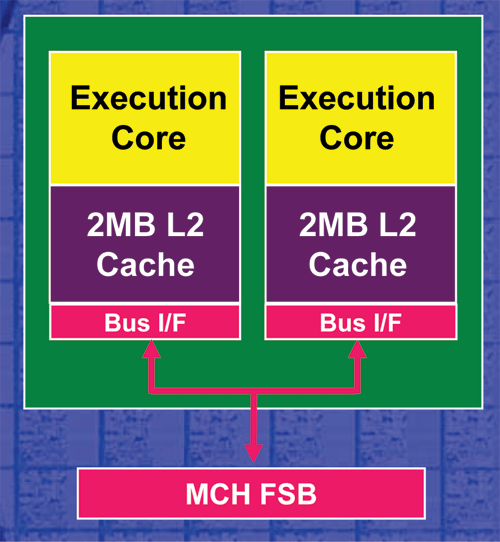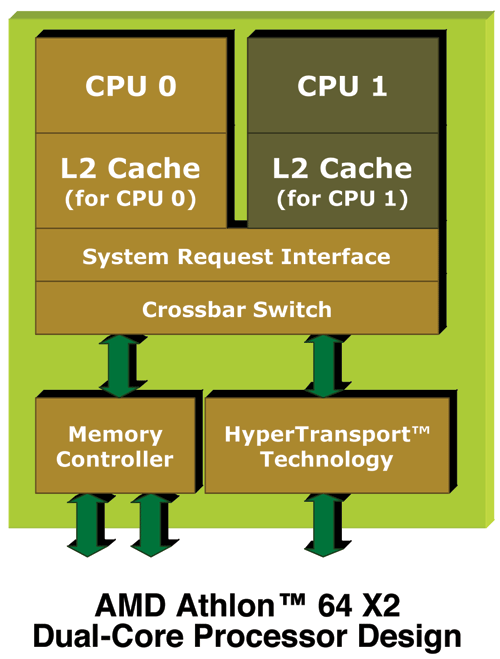AMD's dual core Opteron & Athlon 64 X2 - Server/Desktop Performance Preview
by Anand Lal Shimpi, Jason Clark & Ross Whitehead on April 21, 2005 9:25 AM EST- Posted in
- CPUs
A Look at AMD's Dual Core Architecture
Even Intel will admit that the architecture of the Pentium D is not the most desirable as is two Pentium 4 cores literally glued together. The two cores can barely be managed independently from a power consumption standpoint (they still share the same voltage and must run in the same power state) and all communication between cores must go over the external FSB. The diagram below should illustrate the latter point pretty well:
Intel's Pentium D dual core architecture
AMD's architecture is much more sophisticated, thanks to the K8 architecture's on-die North Bridge. While we normally only discuss the benefits of the K8's on-die memory controller, the on-die North Bridge is extremely important for dual core. Instead of having all communication between the cores go over an external FSB, each core will put its request on the System Request Queue (SRQ) and when resources are available, the request will be sent to the appropriate execution core - all without leaving the confines of the CPU's die. There are numerous benefits to AMD's implementation, and in heavily multithreaded/multitasking scenarios, it is possible for AMD to have a performance advantage over Intel just because of this implementation detail alone.

AMD's solution to the problem will come in the form of DDR2 and a new socket down the road, but for now there's no getting around the memory bandwidth limitations. Intel is actually in a better position from a memory bandwidth standpoint. At this point, their chipsets provide more memory bandwidth than what a single core needs with their dual channel DDR2-667 controller. The problem is that the Intel dual core CPUs still run on a 64-bit wide 800MHz FSB, which makes Intel's problem more of a FSB bandwidth limitation than a memory bandwidth limitation.
Backwards Compatibility
Intel's dual core Pentium D and Extreme Edition won't work in any previous motherboards, but as we mentioned at the start of this article, AMD has more bang. Here, the additional bang comes from the almost 100% backwards compatibility with single-core motherboards. We say "almost" because it's not totally perfect; here's the breakdown:- On the desktop, the Athlon 64 X2 series is fully compatible with all Socket-939 motherboards. All you need is a BIOS update and you're good to go.For desktop users, the ability to upgrade your current Socket-939 motherboards to support dual core in the future is a huge offer from AMD. While it may not please motherboard manufacturers to lengthen upgrade cycles like this, we have never seen a CPU manufacturer take care of their users like this before. Even during the Socket-A days when you didn't have to upgrade your motherboard, most users still did because of better chipsets. AMD's architectural decisions have made those days obsolete. The next generation of dual core processors will most likely need a new motherboard, but rest assured that you have a solid upgrade path if you have recently invested in a new Socket-939 desktop system or Socket-940.
- For workstations/servers, if you have a motherboard that supports the 90nm Opterons, then all you need is a BIOS update for dual core Opteron support. If the motherboard does not support 90nm Opterons then you are, unfortunately, out of luck.










144 Comments
View All Comments
Zebo - Friday, April 22, 2005 - link
It's all good Jep. I was mainly hoping you'd link me to a real live X2 over at xtreme which is why I persisted;)Minotar - Friday, April 22, 2005 - link
All I can say is WOW!!! AMD keeps kicking more and more ass!!!!!!Jep4444 - Friday, April 22, 2005 - link
why would i make this up? im just saying what i was told, for all i know that person made it upPS if anyone tries to comment and i dont respond within the next 3 days, its cause i wont be on, not cause im backing out of what i said
Zebo - Friday, April 22, 2005 - link
Frankey Jep I'm not buying it. It would cost AMD signifigantly more to make these dual 1MB L2 cores different at the core level. 8XX, 2XX, 1XX, and X2 are identical except for tracing in the pakageing and pins to make them function differently. Check out Tomshardware's recent CPU article about AMD manufacturing and you'll see what I'm talking.Jep4444 - Friday, April 22, 2005 - link
im not trying to start a rumour, im very much pro AMD(and if you knew me, i generally dislike attention)all im saying is dont decided it'll be so fast until we see the real thing
Son of a N00b - Friday, April 22, 2005 - link
#107......rumor.....looking for attentin....engineering sample...of course rushed....BIOS........shhhh jep...........period:-P
Filibuster - Friday, April 22, 2005 - link
If you've actually read through this entire thing, congratulations!Jep4444 - Friday, April 22, 2005 - link
#98 what i heard is from word of mouth, not from the site itselfwhile it is true they don't OC very well, apparently the Athlon X2 was rushed and so its functionality wasn't as good as the Opteron 875
from what i hear they don't multi-task nearly aswell as the Opteron does but single threaded performance should still be up to par
the Athlon 64 has had changes made to the ALU amongst other places which would differentiate it from the Opteron aswell
keep in mind i have no actual proof of this and i would love to be wrong but the guys at XS generally know what they're talking about
UzairH - Friday, April 22, 2005 - link
AT should run the doom 3 tests again, this time not using the timedemo but actual gameplay run-throughs. If Doom3 uses a seperate thread for physics then dual-core should definitely benefit.fitten - Friday, April 22, 2005 - link
#102 ++